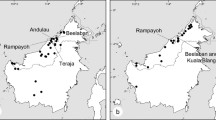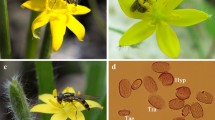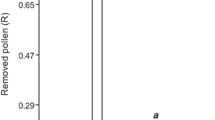Abstract
We studied the biology and floral rewards of 34 taxa ofGenisteae from the SW of Europe. Most of the floral attributes show a statistically significant direct relationship. Anther biomass of the lower whorl (lW) is significantly lower than that of the upper whorl (uW), and the ratio of the two (Rv) differs among the taxa. All taxa are polliniferous, andRetama sphaerocarpa also secretes nectar. They can be considered xenogamous or facultative xenogams on the basis of their high pollen/ovule (P/O) ratios. Three principal mechanisms of pollen releasing are identified in this tribe: valvular, pump and explosive; the latter comprises specialized and nonspecialized subtypes. Pollination is sternotribic except in the specialized explosive mechanism, in which it is noto-sternotribic. Thus some pollen serves as food (pollen from the uW, which adheres to the ventral surface of the insect) and part of the pollen fulfils a polliniferous function (pollen from the lW, which adheres to the dorsal surface). Species that use a pump mechanism have very low Rv values (Rv=0.08−0.26); species with valvular or nonspecialized explosive mechanisms have Rv values between 0.24 and 0.58; those with a specialized mechanism of pollen presentation have high Rv values (0.6−0.76). In contrast to expectations, the highest P/O ratios appear in the specialized explosive system, which allows a single visit from the insect.
Similar content being viewed by others
References
Amici, J. B., 1830: Note sur le mode d'action du pollen sur le stigmate; extrait d'une lettre deM. Amici àM. Mirbel. — Ann. Sci. Nat.21: 329–332.
Arroyo, M. T. K., 1981: Breeding systems and pollination biology inLeguminosae. — InPolhill, R. M., Raven, P. H., (Eds): Advances in legume systematics,2, pp. 723–769. — Richmond: Royal Botanic Gardens, Kew.
Bisby, F. A., 1981: Tribe 32.Genisteae (Adans.)Benth. (1865). — InPolhill, R. M., Raven, P. H., (Eds): Advances in legume systematics,1, pp. 409–425. — Richmond: Royal Botanic Gardens, Kew.
Cresti, M., Blackmore, S., Van Went, J. L., 1992: Atlas of sexual reproduction in flowering plants. — Berlin, Heidelberg, New York: Springer.
Cruden, R. W., 1977: Pollen-ovule ratios: a conservative indicator of breeding systems in flowering plants. — Evolution31: 32–46.
—, 1985: Correlations among stigma depth, style length, and pollen grain size: do they reflect function or phylogeny? — Bot. Gaz.146: 143–149.
—, 1981: Pollen-ovule ratio, pollen size, and the ratio of stigmatic area to the pollen-bearing area of the pollinator: a hypothesis. — Evolution35: 964–974.
Darwin, C., 1896: The different forms of flowers on plants of the same species. — New York: Appleton.
Delpino, F., 1868–1873: Ulteriore osservazione e considerazioni sulla dicogamia nel regno vegetale. — Pt. I, 1868, 1869. Pt. II, fasc. 1, 1870; Milano. — Atti Soc. Ital. Sci. Nat.,11, 1868: 265–332;12, 1869: 21–141, 179–233;16, 1873: 151–349.
Devesa, J. A., 1995: Vegetación y flora de Extremadura. — Badajoz: Universitas.
Erdtman, G., 1960: The acetolysis method — a revised description. — Svensk Bot. Tidskr.54: 561–564.
Faegri, K., Van der Pijl, L., 1979: The principles of pollination ecology. — Oxford: Pergamon Press.
Gallardo, R., Domínguez, E., Muñoz, J. M., 1994: Pollen-ovule ratio, pollen size, and breeding system inAstragalus subgenusEpiglottis (Fabaceae): a pollen and seed allocation approach. — Amer. J. Bot.81: 1611–1619.
Gori, D. F., 1989: Floral color change inLupinus argenteus (Fabaceae): why should plants advertise the locations of unrewarding flowers to pollinators? — Evolution43: 870–881.
Herrera, J., 1985: Nectar secretion patterns in Southern Spanish Mediterranean scrublands. — Israel J. Bot.34: 47–58.
—, 1987: Flower and fruit biology in Southern Spanish Mediterranean shrublands. — Ann. Missouri Bot. Gard.74: 69–78.
Herrero, M., Hormaza, J. I., 1996: Pistil strategies controlling pollen tube growth. — Sexual Pl. Reprod.9: 343–347.
Hideux, M., 1972: Techniques d'étude du pollen au MEB: effects comparés des differents traitements physicochimiques. — Micron3: 1–31.
Horovitz, A., Harding, J., 1972: Genetics ofLupinus. V. Intraspecific variability for reproductive traits inLupinus nanus. — Bot. Gaz.133: 155–165.
Karoly, K., 1992: Pollinator limitation in the facultatively autogamous annual,Lupinus nanus (Leguminosae). — Amer. J. Bot.79: 49–56.
Kay, Q. O. N., 1987: Ultraviolet patterning and ultraviolet-absorbing pigments in flowers of theLeguminosae. — InStirton, C. H., (Ed.): Advances in legume systematics,3, pp. 317–354. — Richmond: Royal Botanic Gardens, Kew.
Knox, R. B., 1984: Pollen-pistil interactions. — InLinskens, H. F., Heslop-Harrison, J., (Eds): Cellular interactions. Encyclopedia of Plant Physiology,17, pp. 508–608. — Berlin, Heidelberg, New York: Springer.
Knudsen, J. T., Olesen, J. M., 1993: Buzz-pollination and patterns in sexual traits in north EuropeanPyrolaceae. — Amer. J. Bot.80: 900–913.
Leppik, E. E., 1966: Floral evolution and pollination in theLeguminosae. — Ann. Bot. Fenn.3: 299–308.
Meeuse, B. J. D., 1961: The story of pollination. — New York: Ronald Press.
Mione, T., Anderson, G. J., 1992: Pollen-ovule ratios and breeding system evolution inSolanum sectionBasarthrum (Solanaceae). — Amer. J. Bot.79: 279–287.
Müller, H., 1883: The fertilisation of flowers. — London: MacMillan.
Ornduff, R., 1969: Reproductive biology in relation to systematics. — Taxon18: 121–133.
Ortega-Olivencia, A., Ramos, S., Rodríguez, T., Devesa, J., 1997: Floral biometry, floral rewards and pollen-ovule ratios in someVicia from Extremadura, Spain. — Edinburgh J. Bot.54: 39–53.
Pazy, B., 1984: Insect induced self-pollination. — Pl. Syst. Evol.144: 315–320.
Petanidou, T., Vokou, D., 1990: Pollination and pollen energetics in Mediterranean ecosystems. — Amer. J. Bot.77: 986–992.
Plitmann, U., Levin, D. A., 1983: Character interrelationships between reproductive organs inPolemoniaceae. — Israel J. Bot.32: 40–41.
Polhill, R. M., 1976:Genisteae (Adans.)Benth. and related tribes (Leguminosae). — Bot. Syst.1: 143–368.
—, 1981: Evolution and systematics of theLeguminosae. — InPolhill, R. M., Raven, P. H., (Eds): Advances in legume systematics,1, pp. 1–26. — Richmond: Royal Botanic Gardens, Kew.
Primack, R. B., 1987: Relationships among flowers, fruits, and seeds. — Annual Rev. Ecol. Syst.18: 409–430.
Proctor, M., Yeo, P., Lack, A., 1996: The natural history of pollination. — London: Harper Collins.
Rice, W. R., 1989: Analyzing tables of statistical tests. — Evolution43: 223–225.
Schaal, B. A., 1989: The population biology of an annual Texas lupine. — InStirton, C. H., Zarucchi, J. L., (Eds): Advances in legume biology. — Monogr. Syst. Bot. Missouri Bot. Gard.29: 283–292.
—, 1980: Pollination and banner markings inLupinus texensis (Leguminosae). — SouthW. Naturalist25: 280–282.
Schrire, B. D., 1989: A multidisciplinary approach to pollination biology in theLeguminosae. — InStirton, C. H., Zarucchi, J. L., (Eds): Advances in legume biology. — Monogr. Syst. Bot. Missouri Bot. Gard.29: 183–242.
Small, E., 1988: Pollen-ovule patterns in tribeTrifolieae (Leguminosae). — Pl. Syst. Evol.160: 195–205.
—, 1987: An expanded circumscription ofMedicago (Leguminosae, Trifolieae) based on explosive flower tripping. — Willdenowia16: 415–437.
Sokal, R. R., Rohlf, F. J., 1979: Biometría. — Madrid: Blume.
Stirton, C. H., 1981: Petal sculpturing in Papilionoid legumes. — InPolhill, R. M., Raven, P. H., (Eds): Advances in legume systematics,2, pp. 771–788. — Richmond: Royal Botanic Gardens, Kew.
Statgraphics, 1994: Statgraphics Plus for Windows version 1.0. — RocKville, MD: Statistical Graphics Corporation.
Systat, 1992: Systat for Windows: Statistics, version 5 edition. — Evanston, IL: Systat, Inc.
Vonhof, M. J., Harder, L. D., 1995: Size-number trade-offs and pollen production by papilionaceous legumes. — Amer. J. Bot.82: 230–238.
Wainwright, C. M., 1978: The floral biology and pollination ecology of two desert lupines. — Bull. Torrey Bot. Club105: 24–38.
Webb, C. J., Shand, J. E., 1985: Reproductive biology of tree lucerne (Chamaecytisus palmensis, Leguminosae). — New Zealand J. Bot.23: 597–606.
Wiens, D., 1984: Ovule survivorship, brood size, life history, breeding systems, and reproductive success in plants. — Oecologia64: 47–53.
Williams, I. H., 1987: The pollination of lupins. — Bee World68: 10–16.
Williams, E. G., Rouse, J. L., 1990: Relationships of pollen size, pistil length and pollen tube growth rates inRhododendron and their influence on hybridization. — Sexual Pl. Reprod.3: 7–17.
Author information
Authors and Affiliations
Rights and permissions
About this article
Cite this article
López, J., Rodríguez-Riaño, T., Ortega-Olivencia, A. et al. Pollination mechanisms and pollen-ovule ratios in someGenisteae (Fabaceae) from Southwestern Europe. Pl Syst Evol 216, 23–47 (1999). https://doi.org/10.1007/BF00985099
Received:
Revised:
Accepted:
Issue Date:
DOI: https://doi.org/10.1007/BF00985099




